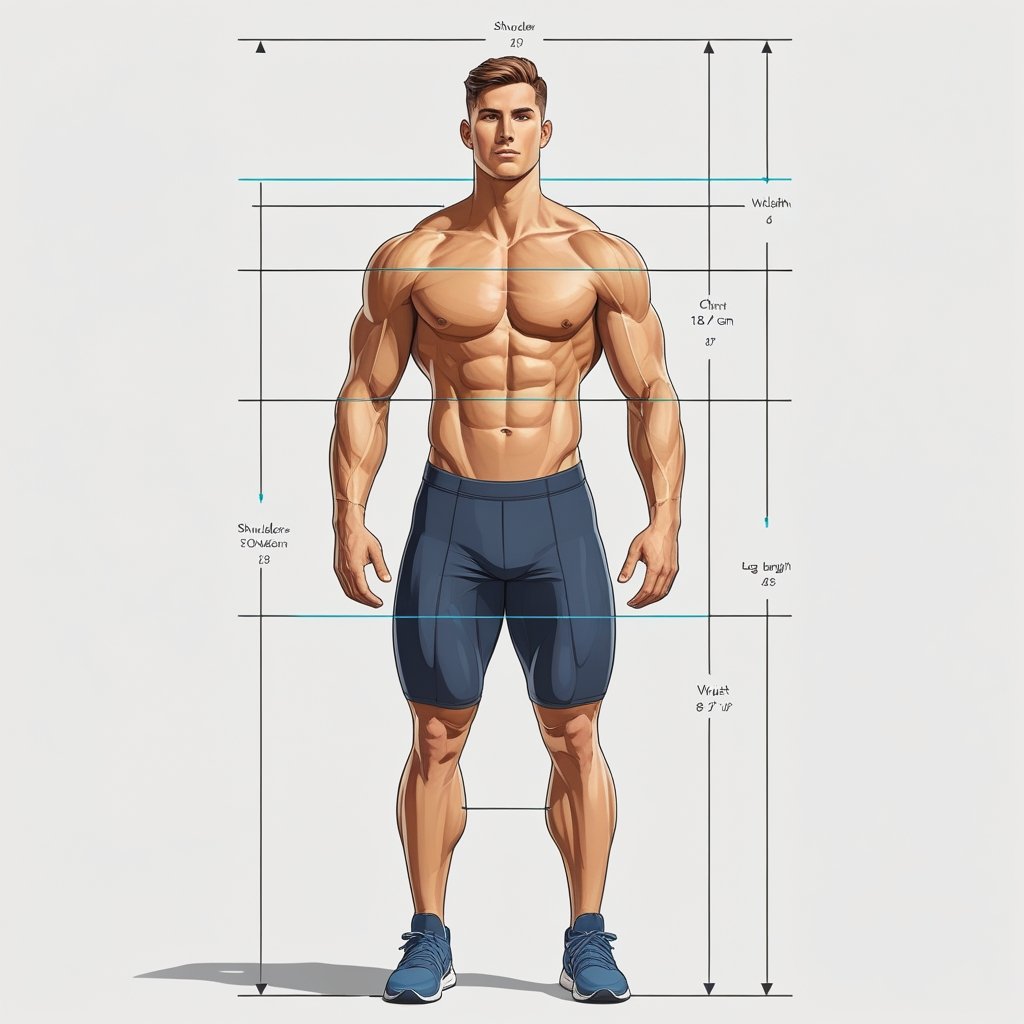The perfect male body measurements according to height are based on timeless proportion formulas, like the golden ratio, and modern health standards. Most experts agree: a shoulder-to-waist ratio close to 1.618, a waist that’s about 45% of your height, and balanced leg-to-torso proportions define the “ideal” male physique. These standards help you not only look your best, but also maintain great health and functional strength.
Understanding perfect male body measurements by height is important because it gives you a science-backed, actionable target—whether your goal is aesthetics, health, or athletic performance. In this guide, you’ll learn the exact ratios, why they matter, and how to realistically achieve them with step-by-step strategies.
- The “golden ratio” is the classic aesthetic guideline (shoulder-to-waist ≈ 1.618).
- Ideal waist circumference is less than 45% of height.
- Reducing body fat and building muscle symmetry are key.
- Compare your measurements, set realistic targets, and use a balanced workout plan.
- Always consult the latest CDC guidelines and a fitness professional if you’re unsure.

What Are the Perfect Male Body Measurements According to Height?
The Golden Ratio & Adonis Index
The golden ratio (about 1.618:1) is widely recognized in art, architecture, and—yes—male body aesthetics. For the male physique, this means:
- Shoulder circumference ≈ 1.618 × waist circumference
- Chest ≈ 1.4 × waist
- Legs ≈ 53% of total height
This ratio isn’t just for show; studies suggest that these proportions are consistently rated as most attractive (NIH, 2023).
Classic Examples:
- A man 5′10″ (178 cm) tall with a 31″ (79 cm) waist should have about a 50″ (127 cm) shoulder circumference for “golden” aesthetics.
- The Adonis Index Calculator lets you enter your height and get personalized targets (Neil’s Toolbox).
Ideal Measurements Table by Height
| Height (inches/cm) | Ideal Waist | Ideal Shoulders | Ideal Chest | Ideal Thighs | Ideal Arms |
|---|---|---|---|---|---|
| 5’6″ (167) | 28.5″ | 46″ | 40″ | 21″ | 14.5″ |
| 5’8″ (173) | 30″ | 48″ | 41.5″ | 22″ | 15″ |
| 5’10” (178) | 31.5″ | 50″ | 43″ | 23″ | 15.5″ |
| 6’0″ (183) | 33″ | 52″ | 44.5″ | 24″ | 16″ |
Source: Muscle & Strength, Legion Athletics, 2024
Why Do These Measurements Matter?
- Attractiveness: Studies show that a higher shoulder-to-waist ratio is consistently rated as more attractive by both men and women (NIH, 2023).
- Health: A waist under 40″ and under 45% of height correlates with lower risks for heart disease, diabetes, and other health issues (CDC, 2024).
- Performance: Balanced proportions support better posture, functional strength, and reduce injury risk.
How to Achieve the Perfect Male Body Measurements
1. Measure Yourself Accurately
- Use a soft tape measure.
- Take measurements at the widest points (shoulders, chest, hips), and narrowest (waist).
- Measure at the same time of day, relaxed, not flexed.
2. Lower Body Fat
- Target: 10–15% body fat for optimal aesthetics and visible muscle.
- Focus on a moderate calorie deficit, high-protein diet, and regular strength training.
- Use a body fat calculator or DEXA scan for accuracy.
3. Build Muscle Proportionately
- Shoulders & Back: Focus on overhead presses, lateral raises, pull-ups, and rows to broaden shoulders.
- Chest: Bench presses, push-ups, and flyes for upper body thickness.
- Waist/Core: Planks, ab rollouts, and rotational core work to build a tight, functional core.
- Legs: Squats, deadlifts, and lunges for proportionate lower-body development.
Sample Weekly Split
- Day 1: Upper Body (Push/Shoulders)
- Day 2: Lower Body (Legs)
- Day 3: Upper Body (Pull/Back)
- Day 4: Core & HIIT
4. Monitor Progress & Adjust
- Re-measure every 4–6 weeks.
- Track nutrition and adjust calories/macros as needed.
- Focus on weak points to bring up lagging muscle groups.
Recent Research and Policy Updates
- The “waist-to-height” ratio is increasingly used as a health screening tool—aim for your waist to be less than half your height (BMJ, 2022).
- New CDC guidelines emphasize waist circumference and body composition over BMI alone (CDC, 2024).
- Most gyms and health pros now use these updated measurements in fitness assessments (see ACE Fitness).
Frequently Asked Questions
What is the fastest way to achieve ideal proportions?
Combine strength training (3–5x/week), a calorie-controlled diet, and focus on building shoulders/upper back while keeping waist tight. Progress is individual, but 3–6 months of consistent effort shows visible results.
Do genetics affect my ability to reach these measurements?
Yes, genetics determine your natural bone structure and muscle insertion points, but almost everyone can improve their ratios significantly with the right approach.
Is the “perfect” physique the healthiest?
Aesthetic ratios generally align with healthy ranges, but never risk your health for numbers alone. Always prioritize sustainable progress.
Conclusion
The perfect male body measurements according to height blend classic aesthetics with modern health science. Focus on the golden ratio for shoulders and waist, aim for a waist under 45% of your height, and use progressive, balanced training. Measure, adjust, and don’t chase perfection—just your personal best!
Ready to transform your physique? Start by measuring, set your targets, and follow a science-backed workout plan. For personalized help, consult a certified trainer or health professional.
